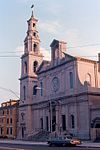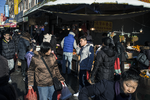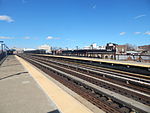St. George Coptic Orthodox Church (Brooklyn)
Christian organizations established in 1973Churches in BrooklynCoptic Orthodox churches in New York (state)Egyptian-American culture in New York CityOriental Orthodox congregations established in the 20th century

St George Coptic Orthodox Church (Coptic: Ϯⲉⲕ'ⲕⲗⲏⲥⲓⲁ ⳿ⲛⲣⲉⲙ⳿ⲛⲭⲏⲙⲓ ⳿ⲛⲟⲣⲑⲟⲇⲟⲝⲟⲥ ⳿ⲛⲧⲉ ⲫⲏⲉⲑⲟⲩⲁⲃ Ⲅⲉ⳿ⲱⲣⲅⲓⲟⲥ // transliteration: ti.eklyseya en.remenkimi en.orthodoxos ente fi.ethowab Gewargios) is one of the oldest Coptic Orthodox churches in North America. It is one of over 200 Coptic Orthodox Churches in the United States.
Excerpt from the Wikipedia article St. George Coptic Orthodox Church (Brooklyn) (License: CC BY-SA 3.0, Authors, Images).St. George Coptic Orthodox Church (Brooklyn)
67th Street, New York Brooklyn
Geographical coordinates (GPS) Address Nearby Places Show on map
Geographical coordinates (GPS)
| Latitude | Longitude |
|---|---|
| N 40.627472222222 ° | E -74.006777777778 ° |
Address
67th Street 1105
11219 New York, Brooklyn
New York, United States
Open on Google Maps








